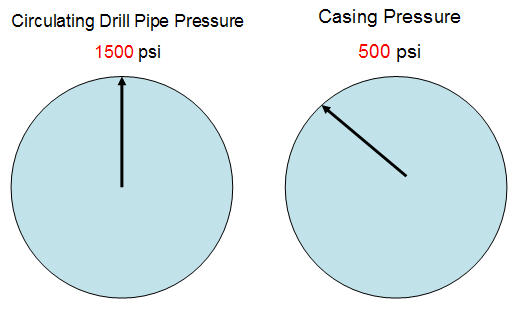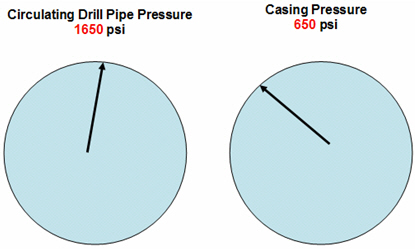Driller's Method Quiz
Quiz-summary
0 of 20 questions completed
Questions:
- 1
- 2
- 3
- 4
- 5
- 6
- 7
- 8
- 9
- 10
- 11
- 12
- 13
- 14
- 15
- 16
- 17
- 18
- 19
- 20
Information
Driller’s method is one of the well control methods which personnel need to fully understand about. This well control quiz focuses on Driller’s Method well control and there are a total of 20 questions relating to theory and calculations. Therefore you need to use a calculator in order to solve some issues in this quiz. In order to get the most out of this quiz, you need to carefully think before choosing any answers and try to read the well control book before. At the end of the quiz, you will see overall score and you will know how good you are. If you have any questions, please feel free to leave in the comments section. We will try to answer you as much as we can.

You have already completed the quiz before. Hence you can not start it again.
Quiz is loading...
You must sign in or sign up to start the quiz.
You have to finish following quiz, to start this quiz:
Results
0 of 20 questions answered correctly
Your time:
Time has elapsed
You have reached 0 of 0 points, (0)
Categories
- Not categorized 0%
- 1
- 2
- 3
- 4
- 5
- 6
- 7
- 8
- 9
- 10
- 11
- 12
- 13
- 14
- 15
- 16
- 17
- 18
- 19
- 20
- Answered
- Review
-
Question 1 of 20
1. Question
From the following list of Shut-In procedure while drilling, which step is followed by “Space out drill string”?
Correct
Incorrect
-
Question 2 of 20
2. Question
What is the purpose of the first circulation of Driller’s method?
Correct
Incorrect
-
Question 3 of 20
3. Question
Which is the correct statement from the following about float Bumping procedure?
Correct
Incorrect
-
Question 4 of 20
4. Question
What is NOT the correct statement of driller’s method well control?
Correct
Incorrect
-
Question 5 of 20
5. Question
What is the most important item from the below list before the kill operation begins?
Correct
Incorrect
-
Question 6 of 20
6. Question
What are the advantages of the Driller’s method?
Correct
Incorrect
-
Question 7 of 20
7. Question
What are the disadvantages of the Driller’s method?
Correct
Incorrect
-
Question 8 of 20
8. Question
What side of pressure should be maintained constant when you need to adjust the flow rate during well control operation?
Correct
Incorrect
-
Question 9 of 20
9. Question
For the FIRST circulation of driller’s method, which pressure must be maintained constant during well kill operation?
Correct
Incorrect
-
Question 10 of 20
10. Question
Many items of information need to be gathered when a well kicks. These include the following EXCEPT;
Correct
Incorrect
-
Question 11 of 20
11. Question
If the slow pump rate is 30 SPM with 400 psi pressure and initial shut inn drill pipe pressure is 300 psi, then what should be approximate initial circulating pressure be?
Correct
Initial circulating pressure = slow pump pressure + shut in drill pipe pressure
Initial circulating pressure = 400 + 300 = 700 psi
Incorrect
Initial circulating pressure = slow pump pressure + shut in drill pipe pressure
Initial circulating pressure = 400 + 300 = 700 psi
-
Question 12 of 20
12. Question
The initial shut-in drillpipe pressure (SIDP) is 500 psi and the current depth is 9,500’ MD / 8,500 TVD. The current mud weigh is 9.5 ppg.
What is the kill weight mud?
Correct
KWM = 9.5 + (500 ÷ (0.052 x 8,500)) = 10.63 ppg.
Round up to 10.7 ppg
Incorrect
KWM = 9.5 + (500 ÷ (0.052 x 8,500)) = 10.63 ppg.
Round up to 10.7 ppg
-
Question 13 of 20
13. Question
The current mud weight is 9.2 ppg and the kill weight mud required is 10.0 ppg. The overall volume to weight up is 500 bbl.
How much barite do you require to weight up the system?
Correct
Sacks of Barite per 100 bbl of mud = 1470 x (W2 – W1) ÷ (35 – W2)
Where; W1 = current mud weight
W2 = new mud weight
Sacks of Barite per 100 bbl of mud = 1470 x (10.0 – 9.2) ÷ (35 – 10) = 47
Total sack required = 47 x 5 = 235 sack
Incorrect
Sacks of Barite per 100 bbl of mud = 1470 x (W2 – W1) ÷ (35 – W2)
Where; W1 = current mud weight
W2 = new mud weight
Sacks of Barite per 100 bbl of mud = 1470 x (10.0 – 9.2) ÷ (35 – 10) = 47
Total sack required = 47 x 5 = 235 sack
-
Question 14 of 20
14. Question
The current mud weight is 9.2 ppg and the kill weight mud required is 10.0 ppg. The overall volume to weight up is 500 bbl.
How much is the volume increase in the system?
Correct
Volume increase per 100 bbl of mud = 100 x (W2 – W1) ÷ (35 – W2)
Where;
W1 = current mud weight
W2 = new mud weight
Volume increase per 100 bbl of mud = 100 x (10.0 – 9.2) ÷ (35 – 10.0) = 3.2 bbl
Total volume increase = 3.2 x 5 = 16 bbl
Incorrect
Volume increase per 100 bbl of mud = 100 x (W2 – W1) ÷ (35 – W2)
Where;
W1 = current mud weight
W2 = new mud weight
Volume increase per 100 bbl of mud = 100 x (10.0 – 9.2) ÷ (35 – 10.0) = 3.2 bbl
Total volume increase = 3.2 x 5 = 16 bbl
-
Question 15 of 20
15. Question
Current mud weigh is 9.5 ppg and the well depth is 9,600’MD/9,000 TVD. The well is shut in and shut in drill pipe pressure is 600 psi.
What is the reservoir pressure at the present depth?
Correct
Reservoir pressure = 600 + (0.052 x 9.5×9,000) = 5,046 psi
Incorrect
Reservoir pressure = 600 + (0.052 x 9.5×9,000) = 5,046 psi
-
Question 16 of 20
16. Question
Before start circulating, you have the following information
Original Shut in Drill Pipe Pressure = 500 psi
Initial Circulating Pressure (ICP) = 1500 psi
After end of 1st circulation of Driller’s Method, the drillpipe pressure gauge and the casing pressure gauge shows that the circulating drill pipe pressure = 1500 psi and casing pressure = 650 psi (see the figure below).

How is this operation?
Correct
There is influx (kick) remaining in well because casing pressure is higher than the original shut in drill pipe pressure. Additional circulation is required for this case.
Incorrect
There is influx (kick) remaining in well because casing pressure is higher than the original shut in drill pipe pressure. Additional circulation is required for this case.
-
Question 17 of 20
17. Question
The first part of Pc Max is determined by which formula?
Before start the first circulating, you have the following information
Original Shut in Drill Pipe Pressure = 500 psi
Initial Circulating Pressure (ICP) = 1500 psi
After end of 1st circulation of Driller’s Method, the drillpipe pressure gauge and the casing pressure gauge shows that the circulating drill pipe pressure = 1500 psi and casing pressure = 500 psi (see the figure below).

How is this operation?
Correct
Everything is looking good. After influx is circulated out of hole, you expect to see casing pressure equal to Initial Shut In Drill Pipe Pressure.
Incorrect
Everything is looking good. After influx is circulated out of hole, you expect to see casing pressure equal to Initial Shut In Drill Pipe Pressure.
-
Question 18 of 20
18. Question
Before starting 1st circulation of driller’s method, you have this following information
Original Shut in Drill Pipe Pressure = 500 psi
Shut in casing pressure = 800 psiAfter complete the 1st circulation, you shut down pumps and you see the drill pipe pressure and the casing pressure as this figure below

How is this operation?
Correct
Everything is perfect. After the kick is circulated out of hole, once you shut down circulation, you should see both gauges reading the same number which is equal to the original shut in drill pipe pressure.
Incorrect
Everything is perfect. After the kick is circulated out of hole, once you shut down circulation, you should see both gauges reading the same number which is equal to the original shut in drill pipe pressure.
-
Question 19 of 20
19. Question
When you shut the well in, you record these following pressure readings.
Initial Circulating Pressure (ICP) = 1500 psi
Original Shut in Drill Pipe Pressure = 500 psi
After you circulate the 1 st step of driller’s method, you see drill pipe pressure and casing pressure reading like this image below.

How is this operation?
Correct
There are 2 possible answers. The first one is that there is still gas in the annulus because the annulus pressure (casing pressure) is not equal to the initial shut in drill pipe pressure.
The second answer is that there is a safety factor applied for this circulation because both pressure readings has the same amount of pressure increment which is 150 psi.
If this situation happens in your real situation, you need to try to shut down and bleed off trapped pressure in the annulus.
Incorrect
There are 2 possible answers. The first one is that there is still gas in the annulus because the annulus pressure (casing pressure) is not equal to the initial shut in drill pipe pressure.
The second answer is that there is a safety factor applied for this circulation because both pressure readings has the same amount of pressure increment which is 150 psi.
If this situation happens in your real situation, you need to try to shut down and bleed off trapped pressure in the annulus.
-
Question 20 of 20
20. Question
When will the casing pressure reach the maximum value?
Correct
Incorrect
Leaderboard: Driller's Method Quiz
| Pos. | Name | Entered on | Points | Result |
|---|---|---|---|---|
| Table is loading | ||||
| No data available | ||||




Happy to interact with the drilling site. Keep educating us on these challenges facing drilling department.
I want to write well control exam but my problem is kill shit . Please I need help
Thanks.
Nubung
Good exercise. I like. Thanks.
Thanks for a good quiz
very good quiz
Refreshing maind never getting old
Thanks for a good quiz😃
Thanks.